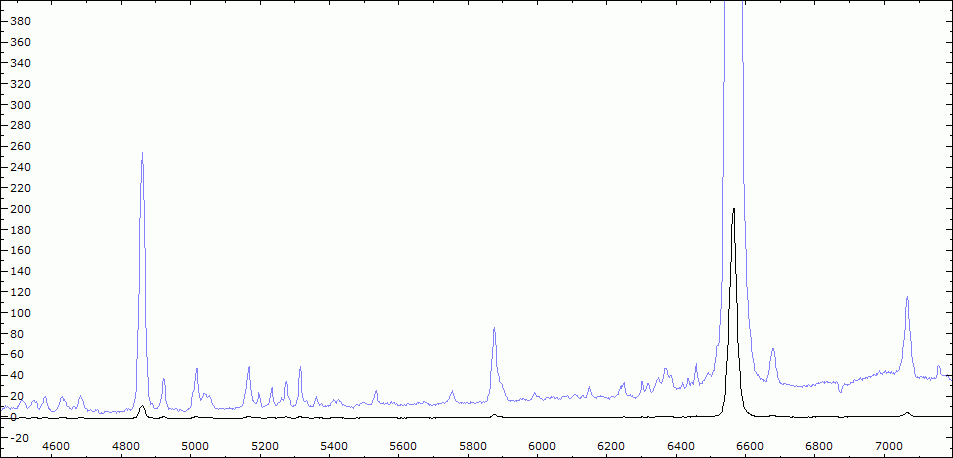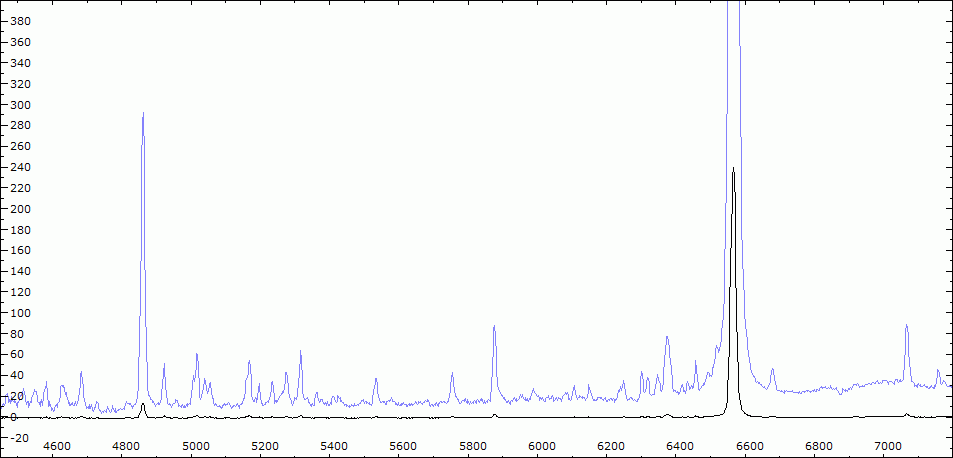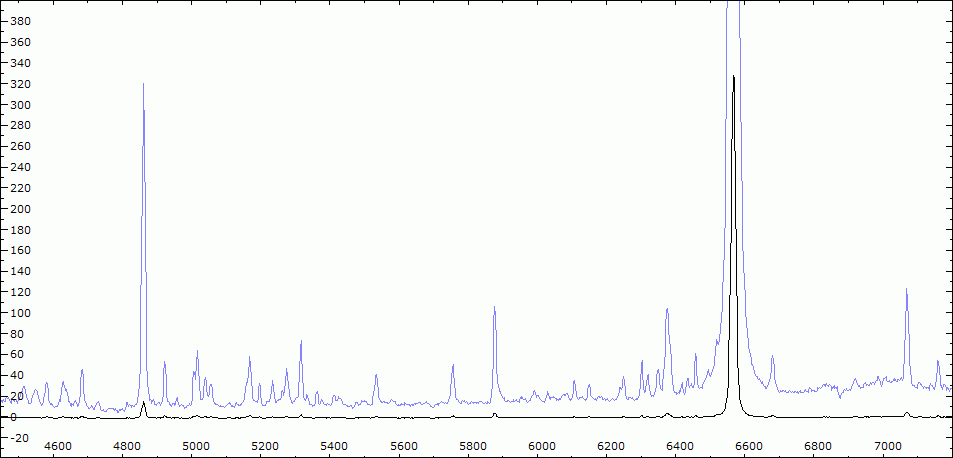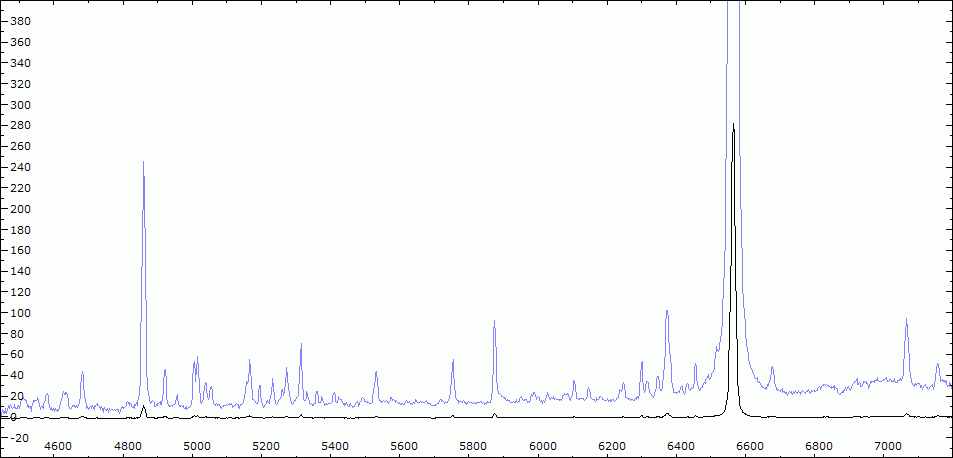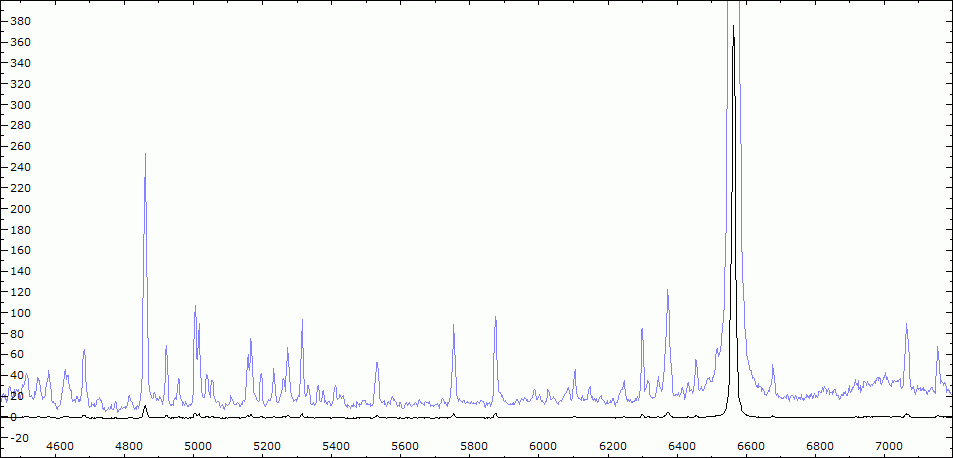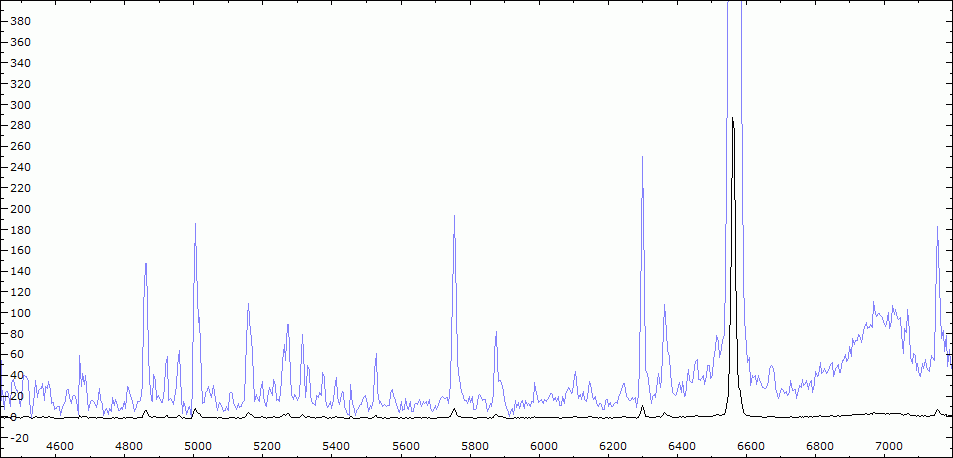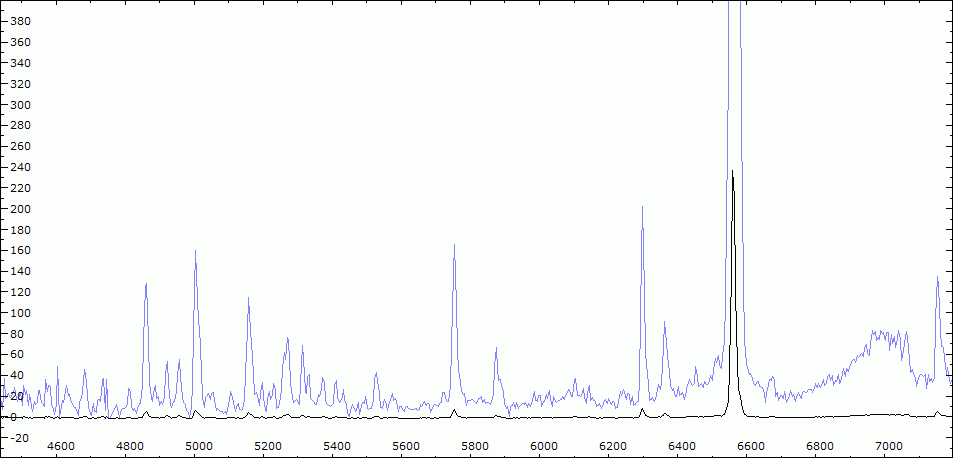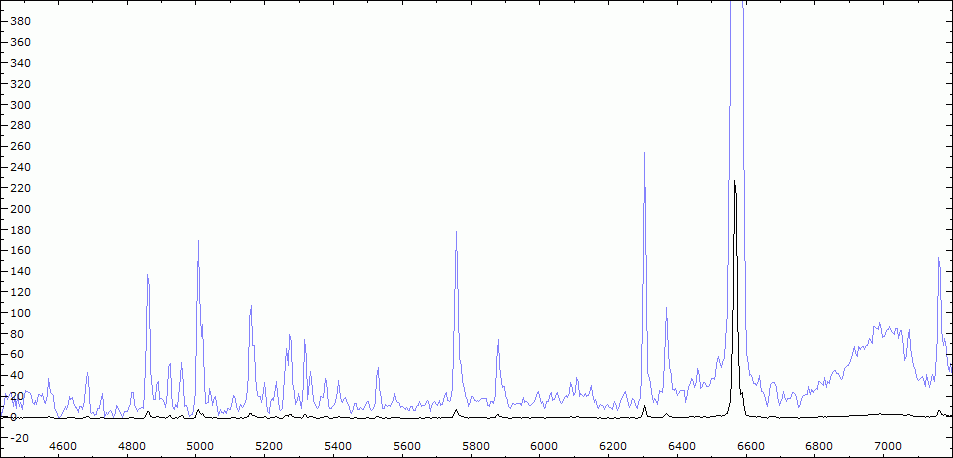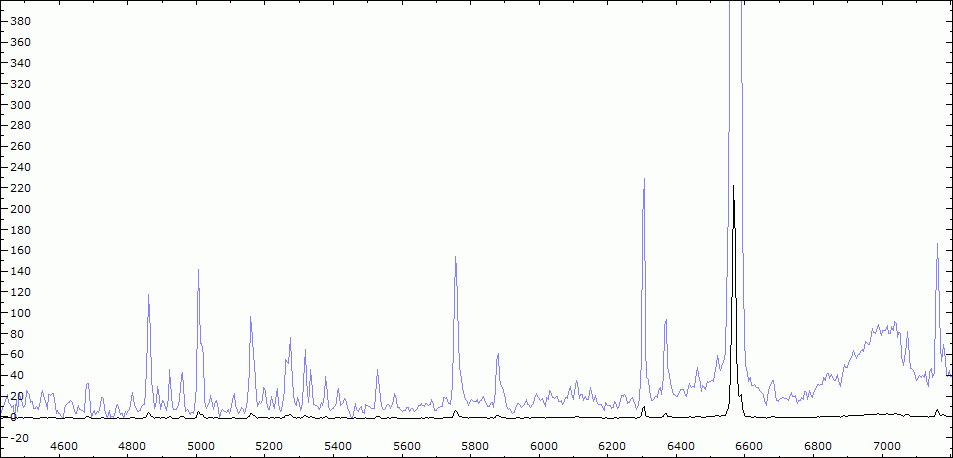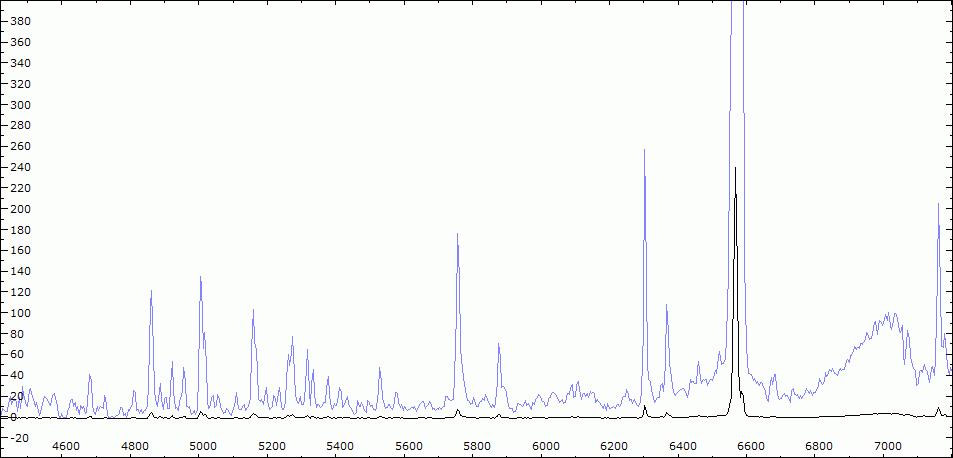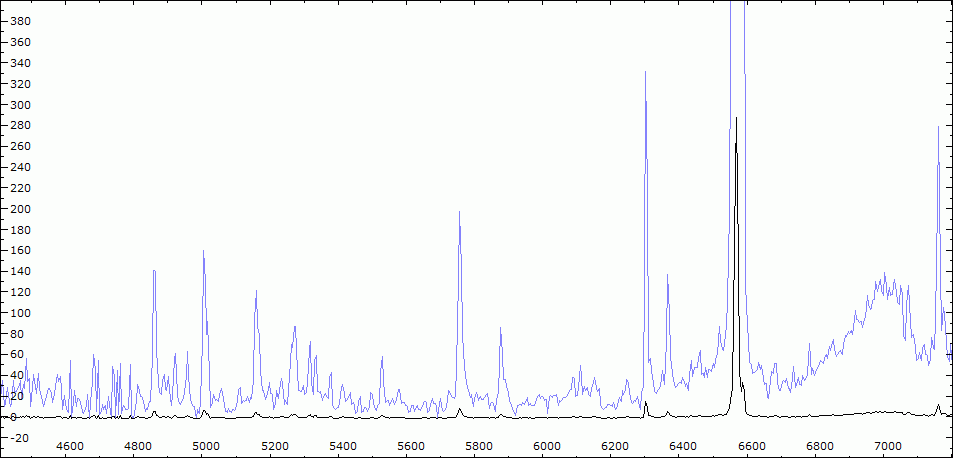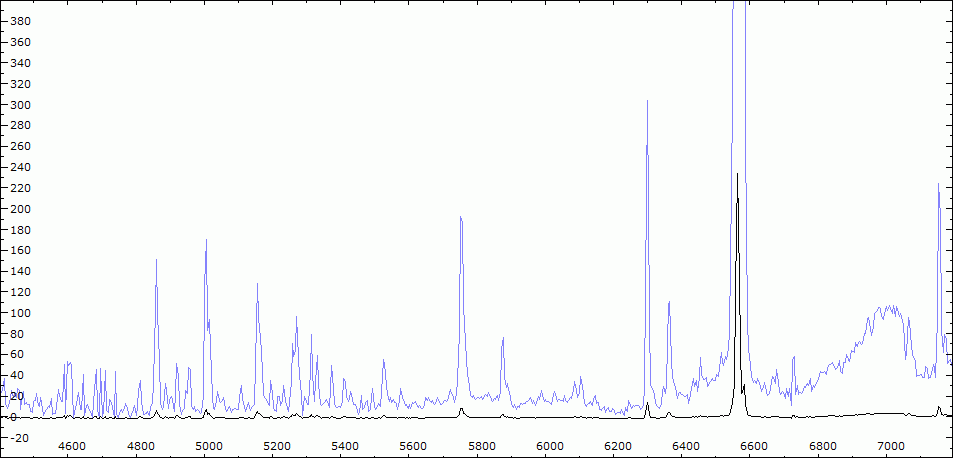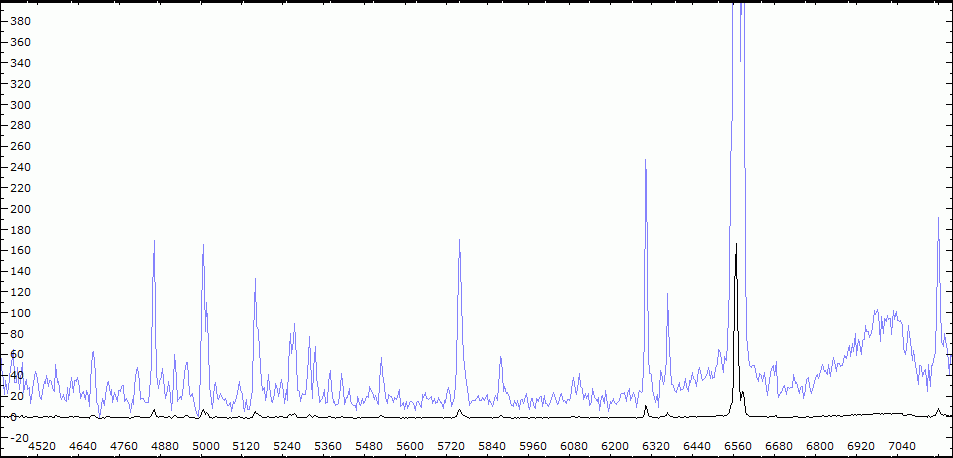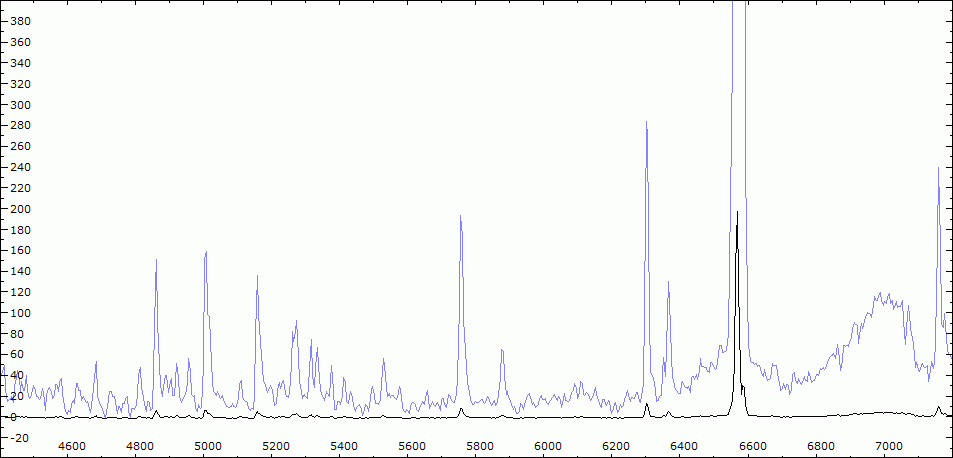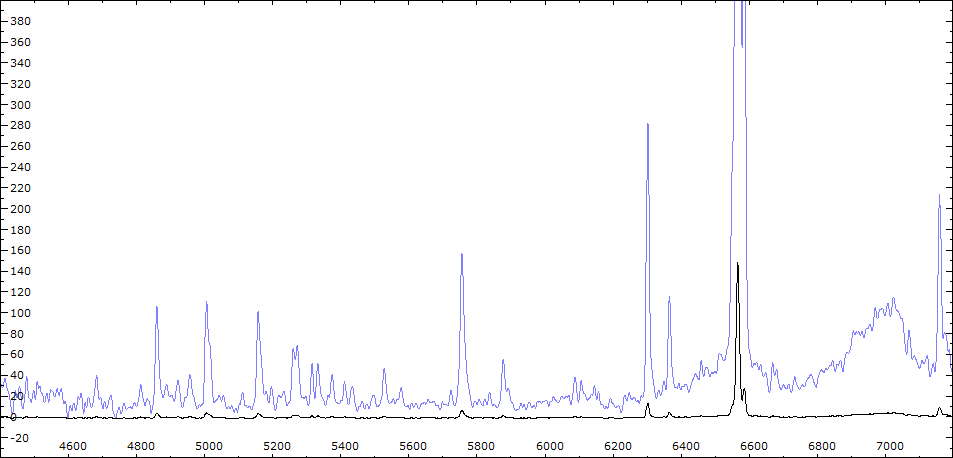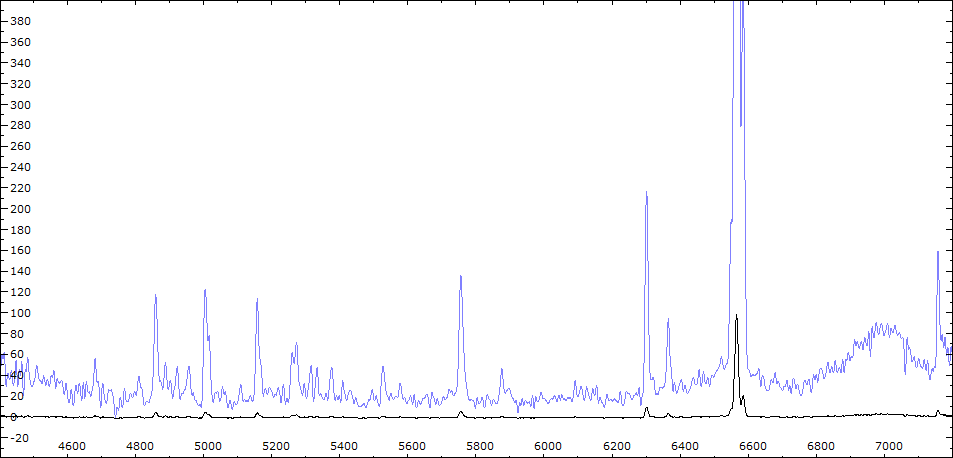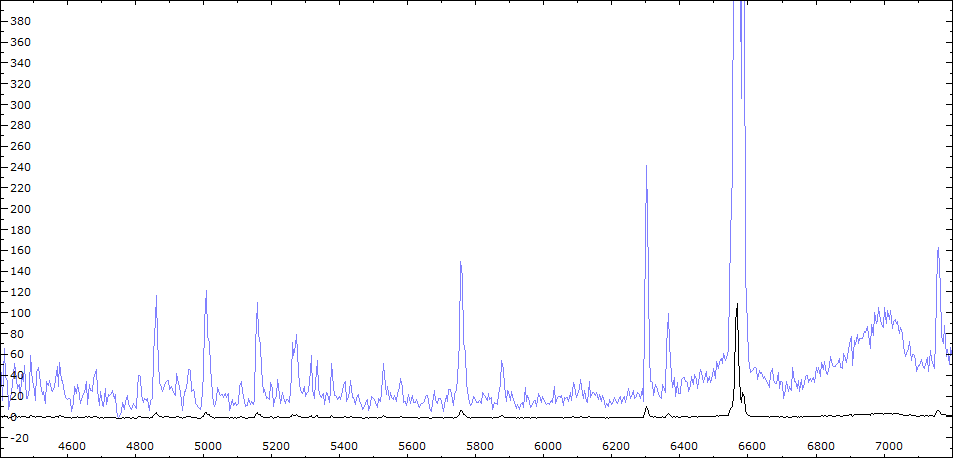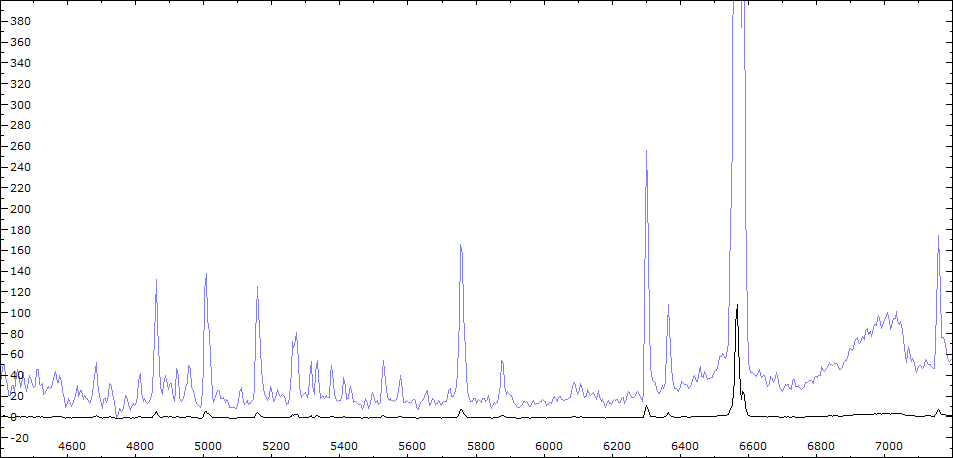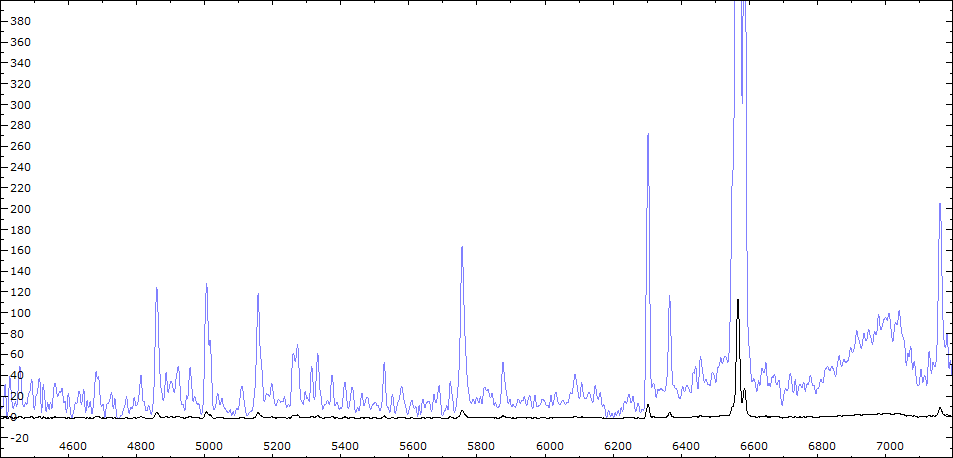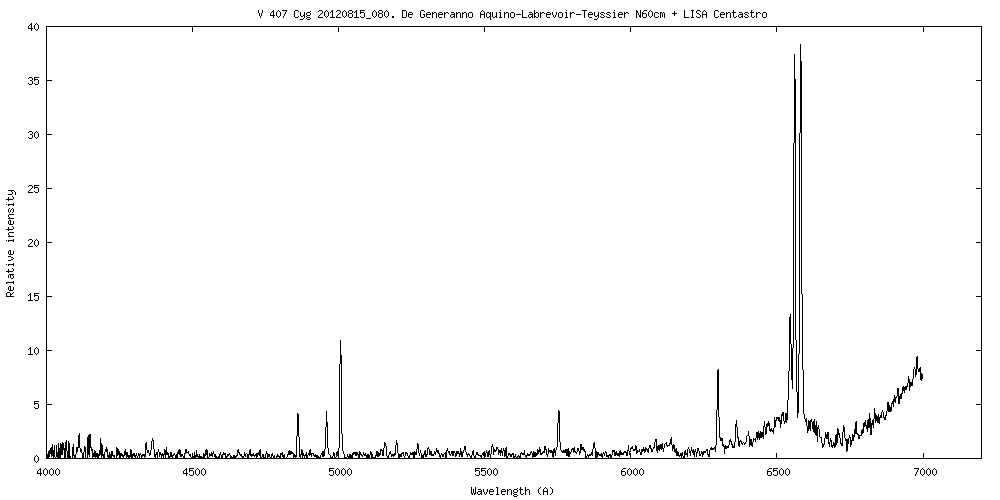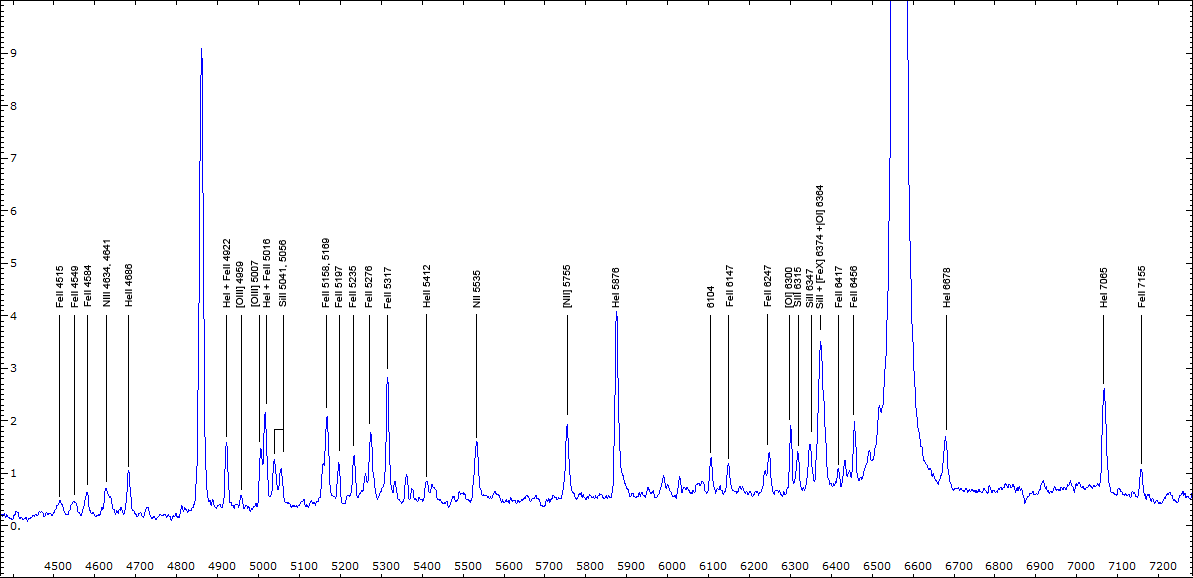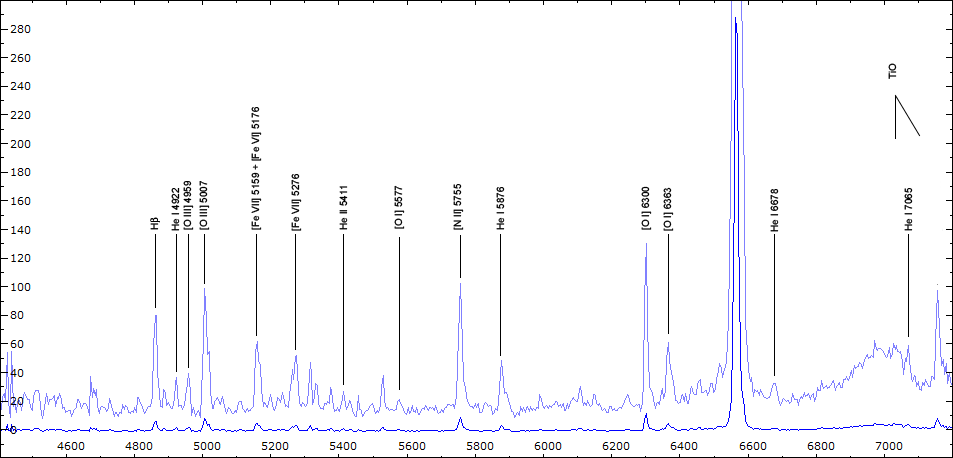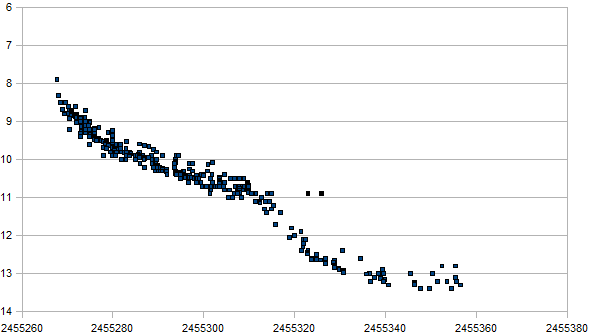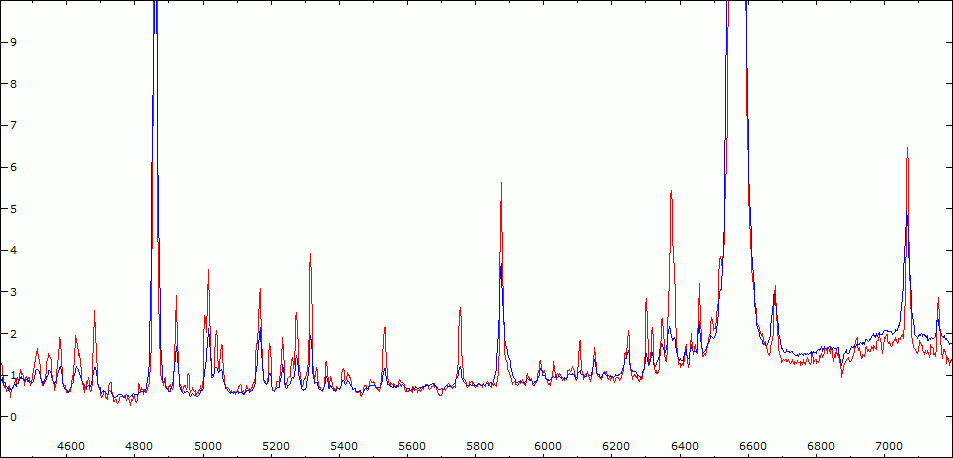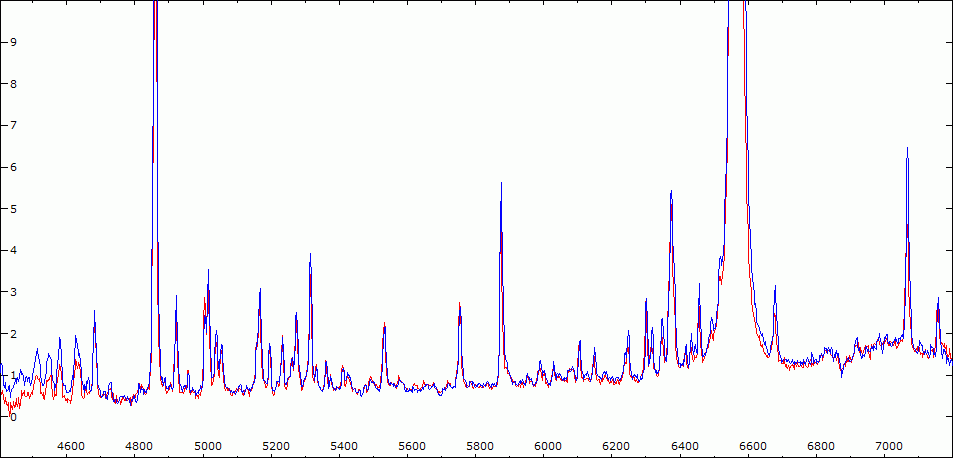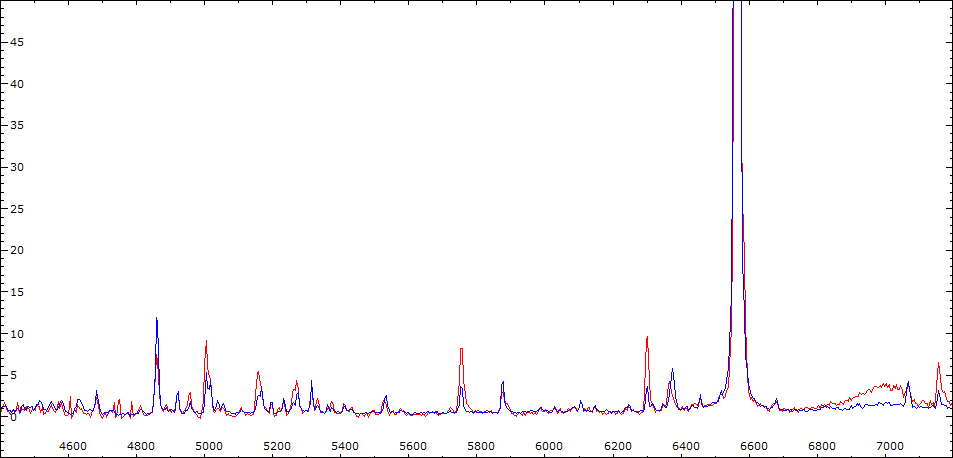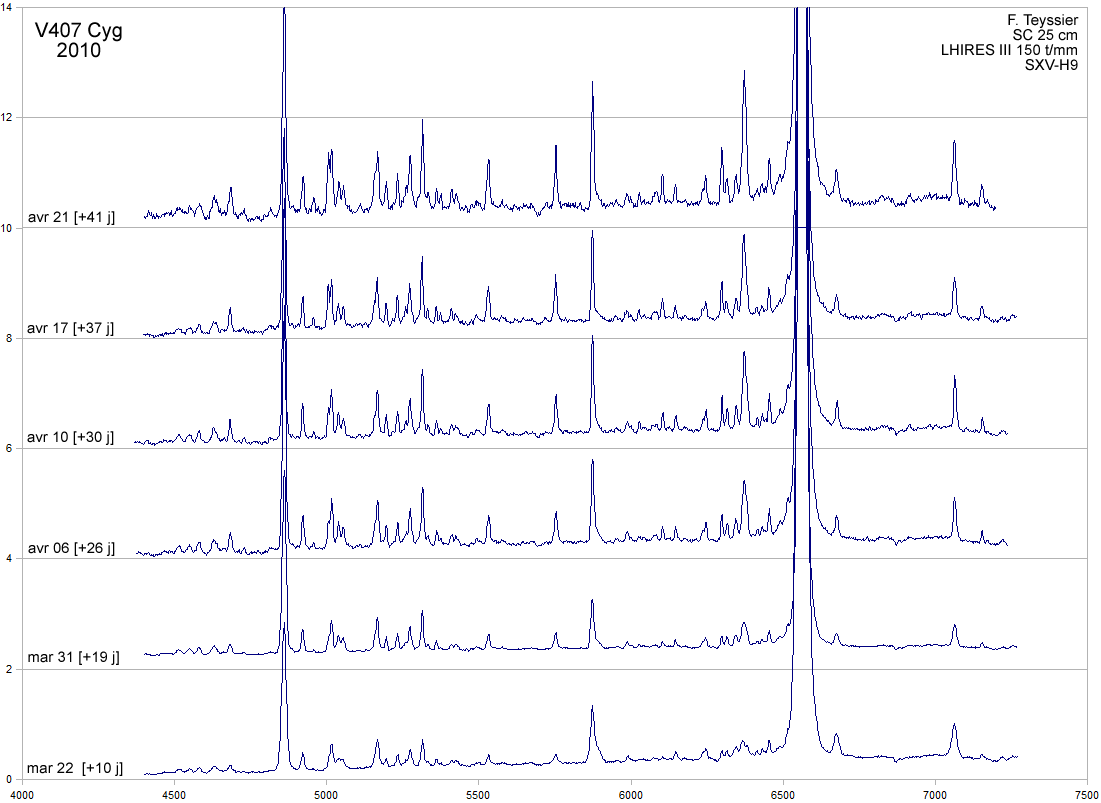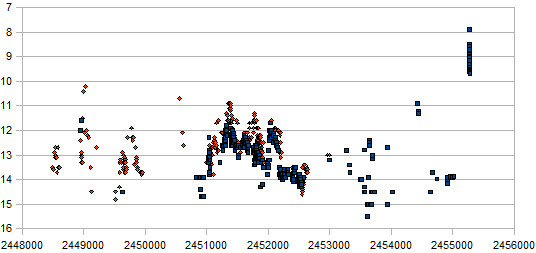Projets Spectroscopie 1
Etoiles Symbiotiques
V407 Cyg - Outburst 2010
AD [2000] DE [2000] Mag P Orb [j] Spec Etoile symbiotique dont la magnitude habituelle est de l'ordre de 14.
Outburst détecté à une magnitude 6.8 le 10 mars 2010 par K. Nishiyama (Fukuoka, Japan) and F. Kabashima (Saga, Japan), and by T. Kojima (Tsumagoi, Agatsuma-gun, Gunma-ken, Japan).
Il s'agit du 3ème outburst enregistré (après ceux de 1936 et 1998), mais cette fois de beaucoup plus grande ampleur.A very bright outburst of this symbiotic star has been discovered by K. Nishiyama (Fukuoka, Japan) and F. Kabashima (Saga, Japan), and by T. Kojima (Tsumagoi, Agatsuma-gun, Gunma-ken, Japan) on 2010 march 10 at a magnitude of 6,8 and 6,9 respectively.
Suivi spectroscopique de l'outburst en basse résolution
Meade LX200 25cm - LHIRES III 150 t/mm - Starlight SXV-H9
Traitement : MaximDL - Iris - VSpec - spectres corrigés par la réponse instrumentale de Véga - normalisation sur la zone 600-610 nmEchelle des intensités relatives identique pour tous les spectres [-40,+400] (courbe noire)
Agrandissement sur une échelle [-2,20] (courbe bleue)Fichier .dat click droit sur
Date Heure TU Exp B V R Phase
Date Heure TU Exp B V R Phase
Date Heure TU Exp B V R Phase
Date Heure TU Exp B V R Phase
Date Heure TU Exp B V R Phase Transparence faible
Date Heure TU Exp B V R Phase
Date Heure TU Exp B V R Phase
Date Heure TU Exp B V R Phase
Date Heure TU Exp B V R Phase
Date Heure TU Exp B V R Phase Apparition bande TiO 7050 de l'étoile primaire
Date Heure TU Exp B V R Phase
Date Heure TU Exp B V R Phase
Date Heure TU Exp B V R Phase
Date Heure TU Exp B V R Phase
Date Heure TU Exp B V R Phase
Date Heure TU Exp B V R Phase
Date Heure TU Exp B V R Phase
Date Heure TU Exp B V R Phase
Date Heure TU Exp B V R Phase
Date Heure TU Exp B V R Phase
Date Heure TU Exp B V R Phase
Date Heure TU Exp B V R Phase
Date Heure TU Exp B V R Phase
Date Heure TU Exp B V R Phase
Date Heure TU Exp B V R Phase
Date Heure TU Exp B V R Phase
Date Heure TU Exp B V R Phase
Date Heure TU Exp B Vis R Phase
Date Heure TU Exp B Vis R Phase Spectre acquis dans des conditions difficiles (pleine lune). 3 poses seulement
______ 2012 _______________________________________________________________________________________________________________ Spectre obtenu au foyer du télescope de 60 cm du Centrastro de Saint Michel l'Observatoire
Mag V ~ 16 (Hiroshi Itoh/VSNET)
Identification des raies le 10 04 2010 :
Identification des raies le 13 05 2010
On voit apparaïtre une bande TiO, signature de la géante rouge qui compose la symbiotique
Courbes de luminosité AAVSO (V+Vis) durant l'outburst de 2010
Evolution
22 03 2010 Bleu
10 04 2010 RougeAugementation de l'intensité relative de toutes les raies.
Développement spectaculaire du blend 6374-6384, dans lequel se trouve [FeX]6374
Apparition de [OIII] 4959 et 5007
10 04 2010 Bleu
17 04 2010 RougeAffaiblissement des raies SiII, HeI et de la plupart des raies FeII
NII et [NII] se maintiennent
[OIII] en augmentation
Diminution sensible de l'intensité relative des raies HI et de la largeur de Ha
27 04 2010 Bleu
13 05 2010 Rouge
Le continuum a fortement diminué d'intensité (mag 12,8 dans le vert)
On voit apparaître une bande d'absortion TiO
Dans l'infrarouge (17 04 2010), non corrigé de la réponse instrumentale.
OI 8448 apparait clairement. On a sans doute [FeXI] 7891.
24 04 2010 - Echelle des intensités logarithmique
V407 Cyg
V407 Cyg est cataloguée comme Mira symbiotique (Allen 1984). La période de pulsation de la mira a été établie à 745 jours avec une amplitude de 3 magnitudes, de 13.5 à >17 (Meinunger, 1966). Cette période est élevée pour une mira. L'intensité de la raie Ha varie fortement (Kolotilov & al. 1998).
Le premier outburst de V407 Cyg (mag 17 à mag 13) a été détecté le 29 août 1936, suivi d'un long déclin jusqu'en août 1939 ; elle a été classée comme nova-like (Hoffmeister (1949)
Ephéméride : Bmax = JD2429710 + 745d * E (Kolotilov & al. 1998)
Photométrie
Observations V et Vis. de l'AFOEV et de l'AAVSO
Liens
Page V407 Cyg Christian Buil http://www.astrosurf.com/buil/v407cyg/obs.htm Page ARAS http://www.astrosurf.com/aras/V407Cyg/v407cyg.htm Article Mike Simonsen dans Sky and Telescope http://www.skyandtelescope.com/observing/highlights/88951267.html Publications
The spectroscopic evolution of the symbiotic-like recurrent nova V407 Cygni during its 2010 outburst. I. The shock and its evolution
S. N. Shore, G. M. Wahlgren, T. Augustijn , T. Liiets, K. L. Page, J. P. Osborne, A. P. Beardmore, P. Koubsky, M. Šlechta, V. VotrubaThe 2010 nova outburst of the symbiotic Mira V407 Cyg
U. Munari, V.H. Joshi, N.M. Ashok, D.P.K. Banerjee, P. Valisa, A. Milani, A. Siviero, S. Dallaporta, F. Castellani
Références
[1] 2007BaltA..16...23S
Baltic Astronomy, 16, 23-25 (2007)
V407 Cyg as a member of a new subclass of symbiotic stars.
SHUGAROV S.Y., TATARNIKOVA A.A., KOLOTILOV E.A., SHENAVRIN V.I. and YUDIN B.F.[2] 2002A&A...383..188M
Astron. Astrophys., 383, 188-196 (2002)
A multi-epoch spectrophotometric atlas of symbiotic stars.
MUNARI U. and ZWITTER T.[3] 2000A&AS..146..407B
Astron. Astrophys., Suppl. Ser., 146, 407-435 (2000)
A catalogue of symbiotic stars.
BELCZYNSKI K., MIKOLAJEWSKA J., MUNARI U., IVISON R.J. and FRIEDJUNG M.[4] 1998PAZh...24..526K
Pis'ma Astron. Zh., 24, 526-535 (1998)
UBVJHKLMN photometry and optical spectrophotometry of the symbiotic Mira V407 Cygni.
KOLOTILOV E.A., MUNARI U., POPOVA A.A., TATARNIKOV A.M., SHENAVRIN V.I. and YUDIN B.F.[5] 1994IAUC.6049....1M
IAU Circ., 6049, 1 (1994)
V407 Cygni.
MUNARI U., BRAGAGLIA A., GUARNIERI D., SOSTERO G., LEPARDO A. and YUDIN B.F.[6] 1984PASAu...5..369A
Proc. Astron. Soc. Australia, 5, 369-421 (1984)
A catalogue of symbiotic stars.
ALLEN D.A.[7] 2009A&A...505..287I
Astron. Astrophys., 505, 287-298 (2009)
Spectral evolution of the recurrent nova RS Ophiuchi during the 2006 outburst and some mysterious phenomena.
IIJIMA T.>> AAVSO Special Notice #201
>>
>> Outburst of the symbiotic star V407 Cyg
>> March 12, 2010
>>
>> Further to Maehara et al. (CBET #2199, D.W.E. Green, editor), the
>> presumed symbiotic star V407 Cyg appears to be undergoing a very bright
>> outburst, well outside of its previous range. This outburst was
>> discovered independently by the team of K. Nishiyama (Fukuoka, Japan)
>> and F. Kabashima (Saga, Japan), and by T. Kojima (Tsumagoi,
>> Agatsuma-gun, Gunma-ken, Japan). Nishiyama and Kabashima observed the
>> star at an unfiltered magnitude of 6.8 on 2010 March 10.813 (JD
>> 2455266.313) and magnitude 6.9 on 2010 March 10.814 (2455266.814).
>> Kojima observed the star at around magnitude 7 on two images taken using
>> a Canon EOS 40D. This is well outside its previously stated range and
>> may indicate a nova outburst in progress.
>>
>> The AAVSO data archive for this object is sparse, and observations of
>> this object are strongly encouraged. Spectroscopy of V407 Cyg is
>> particularly encouraged given both the brightness of the source and the
>> fact that its exact nature is unclear. Suggested classifications for
>> this source include slow nova with either a Mira secondary or Mira
>> component, or a symbiotic star. Spectroscopy and multicolor photometry
>> may provide more information on the nature of this system, while visual
>> observations and time-series photometry will be needed for tracking the
>> overall light evolution of the system.
>>
>>
>> V407 Cyg is located at the following (J2000) coordinates:
>>
>> RA: 21 02 09.85 , Dec: +45 46 33.0
>>
